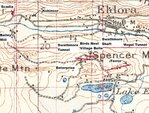

The Eldora Mining District was part of the Boulder County Telluride Boom that in this case resulted in more speculation than actual mining. While looking for gold-and silver-bearing veins, the old-time prospectors often encountered a mineral of strange and peculiar appearance that they referred to as “grey copper or horn copper.” Unable to recover any gold or silver from the vein material by panning or crude milling processes, the old timers considered the rocks as worthless.
In 1873, Professor J. Alden Smith first recognized that veins from the Red Cloud mine on Gold Hill contained gold and silver telluride minerals. The towns of Gold Hill, James Creek, Sunshine, Salina, Providence, Ballarat and Magnolia soon sprang up near these telluride mineral discoveries. From 1872-90 Boulder County telluride mines produced close to $11,000,000 in Gold. The Production came from three main districts; Jamestown ($4,700,000), Gold Hill ($3,360,000) and Magnolia ($3,000,000).
Tellurides are a group of minerals that contain the element tellurium, chemically bonded with gold and silver. Tellurium occurs next to sulfur on the periodic table and will bond with gold and silver to form telluride minerals when there is not enough sulfur in the hydrothermal system to form gold and silver sulfide or sulfosalt minerals. In the 1870s Telluride minerals were quite rare, the only other known occurrences of telluride minerals in the world was in Transylvania, Romania, home of Count Dracula.
In fact, one of the common telluride minerals in Eldora and the Boulder County Telluride District is Sylvanite (AgAuTe4) which is named after its place of discovery in Transylvania. Interestingly, the town of Telluride, Colorado, does not have any Telluride minerals. The Telluride minerals can contain large amounts of gold and silver and free (visible) gold is relatively common in the telluride veins of Boulder County. It was said that hand sorted ore could contain hundreds of ounces of gold per ton.
In 1891, John Kemp located the Happy Valley Placer mining claim to mine the gravel in the steep walled canyon that would become Eldora and Happy Valley camp was founded. Soon, gold-silver telluride veins were discovered at the Enterprise, Village Belle, Virginia, Terror, Bonanza, Gold Coin and Birds Nest claims located near Happy Valley camp.
In 1892, Nederland’s population was 100, and Happy Valley camp (Eldora) had two log cabins and a population of 10. More gold-silver telluride veins were soon discovered above Lost Lake, and the Norway, Maw, and Revenge claims, were located in 1896.
In 1896 the first hotel was opened in Happy Valley camp, the Vendome. In February 1897, Happy Valley camp was renamed Eldorado, and the post office was established. After the postmistress found out that mail was being routed to Eldorado, California, the town’s name was shortened to Eldora. The new town boasted five saloons, a bank, newspaper, and a red-light district across the stream from town that was referred to as “Monte Carlo.”
It was said that five or six houses were started every day this summer. During 1897, the first 60 feet of the Mogul Tunnel, on the south side of the creek from the town, was driven by hand along the Enterprise vein; the tunnel eventually will reach a length of 2600 feet below Spencer Mountain. In 1897, Nederland’s population was 200 and Eldora’s population was 1300.
By 1899, things started to disintegrate; the Enterprise mill could not successfully treat the telluride ores, and the mill manager, Neil Bailey missed a payday. The irate employees set his house on fire and fatally shoot him in the arm.
No amount of promotion could cover up the fact that the mines near Eldora had not produced significant amounts of gold, silver or copper. Many of the Eldora mines burned during a wildfire in 1901, but the main part of town was spared. By 1904, only one saloon was left in Eldora. Desperate to revive mining in the Eldora area, the Fourth of July mine was promoted as a copper mine by local celebrity, Rocky Mountain Joe in 1904. When the railroad finally reached Eldora in 1905 many of the mines were closed, and by 1907 the last operating mine, the Revenge mine above Lost Lake, was closed for good.
In 1900, Nederland’s population was 200, and Caribou’s population was 44.
References
Bastin, E.S., and Hill, J.M., 1917, Economic geology of Gilpin County and adjacent parts of Clear
Creek and Boulder Counties, Colorado: U.S. Geological Survey Professional Paper 94.
Fossett, F., 1876, Colorado, Its Gold and Silver Mines, Farms and Stock Ranges and Health and
Pleasure Resorts: 1st ed., Crawford, N.Y.
Hollister, O.J., 1867, The Mines of Colorado, Samuel Bowles and Co., Springfield Mass., 45 p.
Lovering, T.S., and Goddard, E.N., 1950, Geology and ore deposits of Front Range, Colorado:
U.S. Geological Survey Professional Paper 223, 319p.